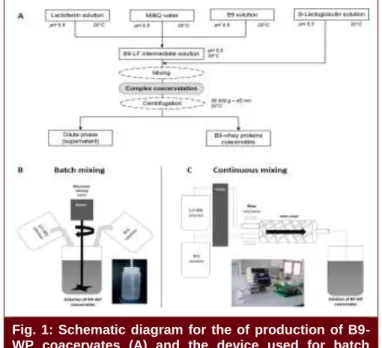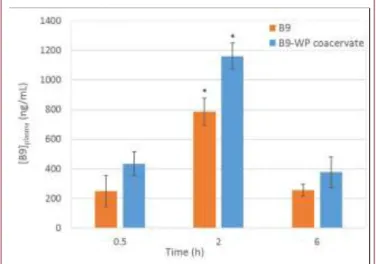HAL Id: hal-01512156
https://hal.archives-ouvertes.fr/hal-01512156
Submitted on 21 Apr 2017
HAL is a multi-disciplinary open access
archive for the deposit and dissemination of
sci-entific research documents, whether they are
pub-lished or not. The documents may come from
teaching and research institutions in France or
abroad, or from public or private research centers.
L’archive ouverte pluridisciplinaire HAL, est
destinée au dépôt et à la diffusion de documents
scientifiques de niveau recherche, publiés ou non,
émanant des établissements d’enseignement et de
recherche français ou étrangers, des laboratoires
publics ou privés.
Distributed under a Creative Commons Attribution - ShareAlike| 4.0 International
License
Bench production and in vivo evaluation of vitamin
loaded whey protein coacervates
Anne Laure Chapeau, Pascaline Hamon, Said Bouhallab, N. Bertrand, D.
Poncelet
To cite this version:
Anne Laure Chapeau, Pascaline Hamon, Said Bouhallab, N. Bertrand, D. Poncelet. Bench production
and in vivo evaluation of vitamin loaded whey protein coacervates. 25. International Conference on
Bioencapsulation, Jul 2017, La Chapelle sur Erdre, France. �hal-01512156�
25th International Conference on Bioencapsulation – Nantes, France – July 3-6, 2017 - Templates
BENCH PRODUCTION AND IN VIVO EVALUATION OF
VITAMIN LOADED WHEY PROTEIN COACERVATES.
Chapeau A.L., Hamon P., Bouhallab S., STLO, UMR1253, INRA, Agrocampus Ouest, 35000 Rennes, France Bertrand N., Faculty of Pharmacy, CHU de Quebec Research Center, Université Laval, G1 V 4G2, Québec Poncelet D., ONIRIS, UMR CNRS GEPEA 6144, 44322 Nantes, France
INTRODUCTION AND OBJECTIVES
While functional foods have prompted growing interest to enhance the daily intakes of specific nutrients and to prevent deficiencies, their processes and storage can affect stability, solubility and bioavailability. To overcome these limitations, one alternative is the encapsulation of agents acting into carriers. To ensure industrial sustainability, such encapsulating material should be natural food-grade components (biocarriers), using economical and reliable raw materials and processes.
The complex coacervation consists in mixing two polymers of opposite charges. Coacervation exploits the balance of electrostatic interactions between the two biopolymers to form a supramolecular assembly. Coacervation may display high shell integrity and encapsulation efficiency, good controlled-release properties and mild preparation conditions. These features are interesting to reduce the industrial processing costs (Yan & Zhang, 2014).
Whey proteins (WP) is by- products of the dairy industry, providing intrinsic biological properties. Two specific whey proteins has been selected β-lactoglobulin (BLG) and Lactoferrin (LF) as they able to co-assemble by complex coacervation. Recently the proof of concept that LF-BLG complex coacervates efficiently entrap vitamin B9 (B9) has been established at laboratory scale (Chapeau et al., 2016). This work focuses on the scale-up production of B9-WP coacervates for potential industrial applications. Coacervation is known to be highly sensitive to processing i.e. working volume, interfaces, and mixing conditions. Empirical scale-up could therefore result in increased costs, resources and efforts (Lemetter et al., 2004). Moreover, B9-WP coacervates should preserve the bioavailability of B9 during oral delivery. As a result, this study aims at: 1) investigating the scale-up production of B9-WP coacervate by comparing two mixing systems (in batch or in continuous), and 2) exploring the bioavailability of orally administered B9-WP coacervates.
MATERIALS AND METHODS
Production and analysis of B9-WP coacervates
The scheme for the production of B9-WP coacervates is presented in Fig. 1A. Stock solutions were prepared as described in Fig. 1 and detailed in (Chapeau et al., 2016). Scaling-up of the production was investigated using two mixing devices, in batch (Fig. 1B) or continuous mode (Fig. 1C). These procedures were investigated at different mixing volumes, stirring speeds and flow rates. B9-WP coacervates solutions were observed by phase contrast microscopy. After centrifugation of B9-WP solutions, B9-WP coacervates were weighted and quantities of B9 and WP recovered in the coacervates were quantified using RP-HPLC according to (Chapeau et al., 2016).
In vivo pharmacokinetics of B9-WP coacervates
Pharmacokinetic studies were performed in male Sprague Dawley rats (≈ 400 g, Charles River, Canada). Prior to experiment, rats had free access to water and were fed ad
libitum for 10 days with a B9 deficient diet (Envigo, USA). Rats
were randomly divided into 2 groups of 5 animals and orally gavaged with various forms of B9 (500 µg/rat): PBS solution of B9, B9-WP coacervates, B9-BLG or B9-LF complex. At different times, 200 µL blood samples were collected through the saphenous vein using capillary tubes. Blood samples were centrifuged and the isolated plasma was kept in microtubes at -20 °C. B9 recovered in plasma was quantified using a competitive enzyme-linked immunosorbent assay.
RESULTS & DISCUSSION
Efficient scale-up production of B9-WP coacervates
Using purified WP (Fig 2. Image A), No difference was observed in the formation of B9-WP coacervates while increasing the volumes from 0.1mL (image B) to 100mL (image C). Increasing the total volume of mixing solutions by a factor 1000 did not prevent the complex coacervation between B9, LF and BLG to occur. However, increases in the mixing volumes of solutions require high amounts of WP. Subsequent purification and filtration steps usually performed at laboratory scale to remove residual protein aggregates may constitute a limit for scale-up and further industrial applications.
With commercial BLG sources, small aggregates are clearly visible (image D), and solutions present higher turbidity.
Fig. 1: Schematic diagram for the of production of B9-WP coacervates (A) and the device used for batch mixing by mechanic stirring (B) or continuous mixing by static stirring (C).
25th International Conference on Bioencapsulation – Nantes, France – July 3-6, 2017 - Templates
However, B9-WP coacervates obtained with commercial BLG solution (Fig 2D) were similar to the ones obtained with purified and filtered WP solutions at 100mL mixing volume (Fig. 2B). Regardless the purity of the BLG solution, similar quantities of B9 and WP were recovered in the coacervates (unshown data). Same experiments were conducted to test LF purification leading to the same results as with BLG (unshown data). As a result, the production of B9-WP coacervate can then be performed at larger volumes using commercial protein solutions without further purification steps.
In 100 mL batch, without mixing, B9 entrapment yield in WP coacervates reached 46 % and yield of coacervates is limited to 24 % (Fig. 2). With increased stirring, optimum conditions were found with a 2 min stirring at 150 rpm, allowing to double both the B9 encapsulation efficiency and WP coacervate yield, similar to the efficiency obtained at laboratory scale (Chapeau et al., 2016).
For continuous mixing, B9 entrapment yield approached 100 % for 200 and 300 mL/min and coacervation yields of 65 % for 300 mL/min were reached, superior to the one obtained previously at laboratory scale. Thus, static mixer system allowed to reach large productivity (18 kg/h for still with lab scale equipment) with good encapsulation performances. These results were in agreement with previous studies on the production of protein-polysaccharides coacervates using continuous stirring for mixing solutions (van Swaay et al., 2015), demonstrating the potential of producing coacervates using only an heteroprotein systems for further industrial use.
Improved oral delivery of B9 by B9-WP coacervates
Pharmacokinetics of orally administered free or entrapped B9 in B9-WP coacervates were compared. According to the results presented on Fig 3., the maximum B9 concentrations in rat plasma (Cmax) were obtained within 2 hours post gavage, both
for free and entrapped B9. The group receiving B9-WP coacervates showed the highest Cmax, demonstrating that the
encapsulation of B9 in WP coacervates increased its overall absorption.
These results could be explained by the ability of coacervates to increase the apparent solubility of B9, especially at acidic stomach pH values. Since molecules need to be dissolved to
be absorbed through the gastro-intestinal wall, any interactions preventing the precipitation of B9 could be beneficial to increase its overall bioavailability.Control injections using B9 complexed to BLG and LF, showed Cmax value similar to free B9 rather than
B9-WP coacervate, proving the beneficial effect of WP coacervate over one protein alone.
CONCLUSIONS & PERSPECTIVES
Under optimized conditions, bench scale efficiency similar to that found for laboratory scale was reached (65 % coacervation, 98% B9 entrapment), proving an efficient scale-up by continuous mixing with static stirring. In vivo absorption of coacervates showed an enhanced bioavailability of B9 compared to the free vitamin, probably due to an improvement of the vitamin's solubility and its protection in the gastro intestinal tract. This study demonstrates the potential of increasing the scale production of WP coacervates as natural encapsulating agents to enhance the bioavailability of bioactive. Further research should be undertaken to add this system into a food matrix for functional food development.
REFERENCES
● Chapeau, A.-L., Tavares, G. M., Hamon, P., Croguennec, T., Poncelet, D., & Bouhallab, S. (2016). Food Hydro., 57.
● Lemetter, C. Y. G., Meeuse, F. M., & Zuidam, N. J. (2009).
AIChE Journal, 55(6)
● Paul, E. L., Atiemo-Obeng, V. A., & Kresta, S. M. (2004).
Handbook of Industrial Mixing. John Wiley & Sons.
Simone, G. (2016). Chem. Eng. Res. & Des., 105.
● van Swaay, D., Tang, T.-Y. D., Mann, S., & de Mello, A. (2015). Ang. Chem. Int. Edition, 54(29),
● Yan C., Zhang W. (2014). Microencapsulation in the Food
Industry (pp. 125–137).
Acknowledgements
Experiments were approved by the Institutional Committee of the CHU de Quebec Research Center (protocol 2015074-2). We are grateful to Regional councils of Brittany and Pays de la Loire (grant n°13008651 and n° 2014-07081) and INRA for financial support through the interregional project PROFIL, supported by Bba and managed by “Pôle Agronomique Ouest”.
Fig. 2: Microscopic images of B9-WP coacervates solution depending on BLG sources and mixing volume (left). B9 entrapment and WP coacervation yields obtained by two mixing systems at different stirring or flow rates (right).
Fig. 3: B9 concentrations in rat plasma (ng/mL) vs time after oral administration (T0) of 500 ug of B9 or B9-WP coacervate solutions. Tuckey tests used to identify statistical differences, p<0.05

